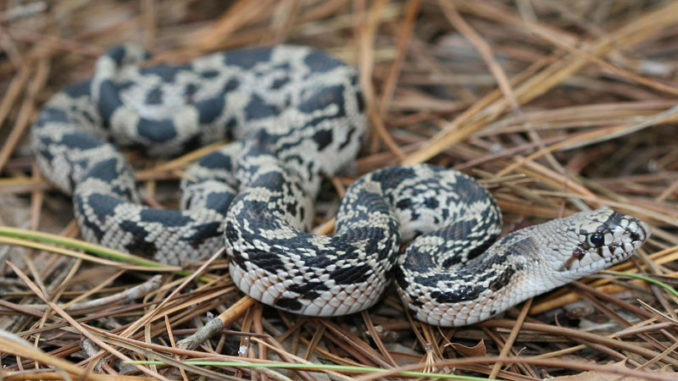
The NCWRC would like to hear of sightings in SW N.C.
Practicing social distancing by taking long walks in wooded areas? If so, biologists with the N.C. Wildlife Resources Commission are asking you to report any sightings of pine snakes you see to the agency.
Biologists want to learn more about the distribution of northern pine snakes in southwestern North Carolina. Pine snakes are large, non-venomous snakes that spend most of their time underground. Spotting one is no easy task given their burrowing tendencies. However, spring is the best time to see one as they are more likely to be above ground this time of year, seeking mates and food, basking in the sun, or moving from burrow to burrow.
Because of their size, pine snakes are fairly easy to spot when above ground. They typically range between 4 to 5 feet long. And some can get as large as 7 ½ feet. They have a white, tan or yellowish background color with dark brown or black markings that begin as heavy mottling on the head before gradually becoming distinct blotches toward the tail.
In North Carolina, pine snakes are found mostly in the Sandhills and the southern Coastal Plain. But confirmed records have also come from Cherokee and Swain counties. Pine snakes prefer open areas within pine-oak forests with well-drained and sandy soils.
Have you seen one?
People who see a pine snake in the wild are asked to send an email to pinesnake@ncwildlife.org.
Please include the following information:
- A photo (required)
- Date and time the snake was observed
- The location (GPS coordinates are best, but a detailed location description is acceptable)
Anyone who spots a pine snake in the wild should admire the reptile from a distance and not attempt to pick one up or touch one, said Sam McCoy, a wildlife technician with the Commission. While the pine snake is neither dangerous nor venomous, it is protected in North Carolina.
“Despite the fact that pine snakes are seldom seen, the species appears to be declining throughout much of its range,” McCoy said. “Because of this, the pine snake in North Carolina is state-listed as threatened and cannot be collected or taken from the wild without a permit.”
To get a better understanding of pine snake populations in Cherokee and Swain counties, the Commission is working with the Eastern Band of Cherokee Indians to conduct surveys in areas where pine snakes have either been seen or in areas with potentially suitable habitat. The Commission has constructed camera traps, which can document snakes passing through the area.
“It’s difficult to conserve a species like the pine snake when we don’t even know all the places it occurs,” McCoy said. “Citizens can really help us out by providing records of pine snakes they see.”



Be the first to comment